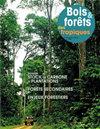塞内加尔萨巴的人口变异性(A. DC.)根据布基纳法索的气候梯度
IF 0.6
4区 农林科学
Q3 FORESTRY
引用次数: 3
摘要
塞内加尔沙巴(A. DC.)Pichon,也被称为weda藤蔓,是夹竹桃科的一种木本藤蔓。从该树种获得的非木材林产品在布基纳法索具有重要的社会经济意义,但其人口特征鲜为人知,尽管它们对执行可持续管理方案很重要。本研究根据气候梯度评估了塞内加尔沙蝇的种群特征。采用目标随机抽样法,建立1000 m2小区进行种群调查。在根颈处和离地1.30 m处测量成虫茎粗,在离地20 cm处测量幼苗茎粗,在根颈处测量成虫茎粗。计算了绿指数、密度、平均茎粗和基面积,并进行了气候带间的比较。结果表明,根据格林指数,塞内加尔南芥属植物呈块状分布。不同气候带间的密度、平均直径和基面积差异显著(p < 0.05)。在萨赫勒和苏丹地区发现了高密度的塞内加尔沙蚊成虫。一般线性模型表明,温度和降水对塞内加尔杉木的建立和更新有影响。种群结构显示幼木丰富,种群更新潜力大。尽管塞内加尔南檀的种群表现出一定程度的恢复能力,但日益恶化的气候和人类的压力正在危及该物种在其自然栖息地的保护。本文章由计算机程序翻译,如有差异,请以英文原文为准。
Variabilité démographique de Saba senegalensis (A. DC.) Pichon suivant le gradient climatique au Burkina Faso
Saba senegalensis (A. DC.) Pichon, also known as the weda vine, is a woody vine from the Apocynaceae family. The non-timber forest products obtained from this species are of major socio-economic importance in Burkina Faso, but its demographic characteristics are little known despite their importance for the implementation of sustainable management programmes. This study assessed the demographic characteristics of S. senegalensis according to the climate gradient in Burkina Faso. Targeted random sampling was used to establish 1,000 m2 plots for a population inventory. Dendrometric measurements of stem diameter were made at the root collar and at 1.30 m above the ground for adult individuals, 20 cm from the ground for young plants and at the root collar for seedlings. The Green index, density, average stem diameter and basal area were calculated and comparisons made between climatic zones. The results showed a clumped distribution of S. senegalensis according to the Green index. Density, average diameter and basal area varied significantly (p < 0.05) between climatic zones. High densities of adult S. senegalensis are found in the Sahelian and Sudanian zones. The general linear model shows that temperature and precipitation have an influence on the establishment and regeneration of S. senegalensis. The demographic structure shows an abundance of juvenile plants with high potential for the renewal of populations. Although S. senegalensis populations show a degree of resilience, the deteriorating climate and human pressures are jeopardising the conservation of the species in its natural habitat.
求助全文
通过发布文献求助,成功后即可免费获取论文全文。
去求助
来源期刊

Bois et Forets Des Tropiques
FORESTRY-
CiteScore
1.50
自引率
16.70%
发文量
31
审稿时长
>12 weeks
期刊介绍:
In 1947, the former Tropical Forest Technical Centre (CTFT), now part of CIRAD, created the journal Bois et Forêts des Tropiques. Since then, it has disseminated knowledge and research results on forests in intertropical and Mediterranean regions to more than sixty countries. The articles, peer evaluated and reviewed, are short, synthetic and accessible to researchers, engineers, technicians, students and decision-makers. They present original, innovative research results, inventions or discoveries. The journal publishes in an international dimension. The topics covered are of general interest and are aimed at an informed international audience.
 求助内容:
求助内容: 应助结果提醒方式:
应助结果提醒方式:


